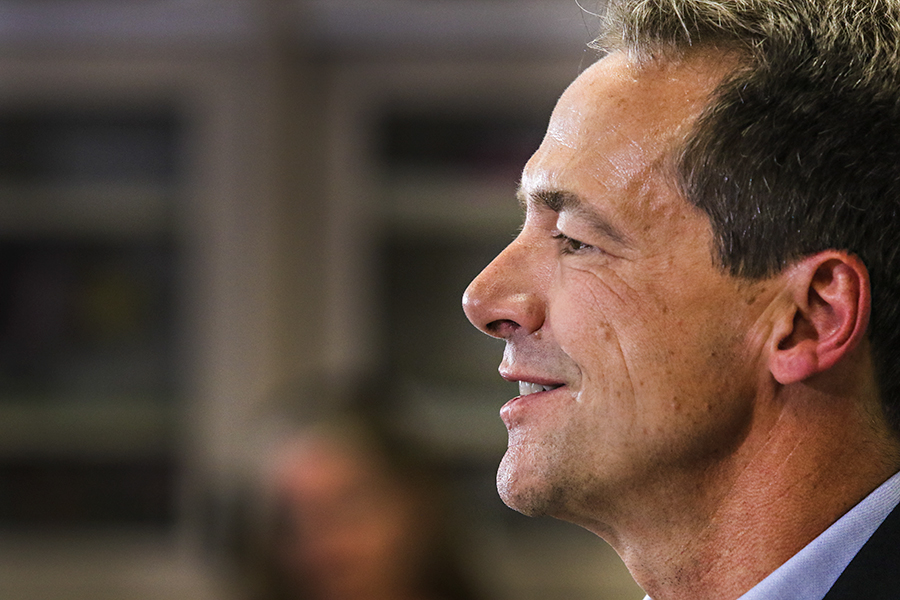Gov. Steve Bullock expressed concern at a press conference today about the continued rising number of COVID-19 cases in Montana and the simultaneous record level of hospitalizations.
“Public health experts, doctors and nurses have been joining me at these press conferences for the past couple of months to try and sound the alarm,” Bullock said. “The alarm is undoubtedly ringing loudly.”
Bullock pointed to the parabolic rise of cases in the state, where it took nearly six months to reach the first 10,000 reported COVID-19 cases, 25 days to reach the second 10,000, 15 days to reach the third and just 10 days to reach the fourth.
“Dang near every state in the nation is facing uncontrollable spread,” Bullock said. “In Montana we too are facing record hospitalizations and the death toll is on the rise.”
Statewide, 499 people are currently hospitalized with the disease, and the latest report from the Department of Public Health and Human Services indicates that five of the 10 largest hospitals in Montana are past 90% bed occupancy.
In the month of October, 20,052 Montanans were infected with COVID-19. The governor made an estimate that with four close contacts per positive case, that meant that a population roughly the size of Billings, or of Flathead County, had to isolate or quarantine for part of the month of October.
He called out Congress for not passing any additional coronavirus relief legislation since spring, and pointed to the lack of additional unemployment benefits, stimulus checks and paycheck protection as a concern for Montanans. Bullock said that one reason he is not currently considering an additional shutdown order was because there is little financial support left from the federal government that could help Montanans through another shutdown. Of the $1.25 billion in coronavirus relief funds the federal government allocated to Montana in March, $1.23 billion has already been committed to various grant programs and reimbursements for coronavirus expenses.
“There’s very little that can be done from the state level for those businesses at this point,” Bullock said.
The governor offered up praise for hotspot communities in the state that took initiative and implemented stricter measures aimed at controlling the spread, specifically recognizing the efforts of Missoula, Billings, Great Falls, Bozeman and Butte.
“We have mask requirements in place for all but five counties in our state,” Bullock said, citing a study from the University of Washington that projected 600 lives could be saved over the next few months if Montanans followed these requirements.
In regards to the upcoming transition of power to the governor-elect, Bullock said his staff has engaged in initial discussions with the transition team and offered the support of the coronavirus response team to the incoming administration. While there have been “constructive discussions,” Bullock said no meetings have occurred.
The state’s infectious disease expert, Jim Murphy, also spoke about the state’s testing capacity, saying that Montana is on track to have 230,000 rapid tests by the end of the year, which are primarily being sent to facilities that need to test symptomatic individuals, in addition to continuing PCR testing.
“The testing that we’ve been doing has been at what seems like record levels for us,” Murphy said. “The volumes are really high right now.”
Murphy also said the state is planning to do saturation testing and surveillance testing in higher-risk areas.
The state is also working to finalize plans for vaccine distribution, which includes identifying sites capable of storing a version of the vaccine that requires extreme cold, setting up distribution planning groups and plotting out target groups considered high risk by the federal government that will be part of the first phase of vaccine distribution.
“We’re optimistic that we’re in as good of a position as anyone right now to be able to receive the product as it becomes available and work with our partners in the private and public sector to make sure the vaccine is administered,” Murphy said.
The press conference also yielded time to state epidemiologist Stacey Anderson, who ran through the latest COVID-19 statistics for Montana, noting that one in every 24 Montanans has been diagnosed with the disease and last week’s 7,300 reported cases represented a 29% increase from the previous week. She also offered advice for Montanans heading into the holiday season.
“We’re all tired, we all miss our families,” Anderson said. “The risk, though, is getting to be too high in some places in Montana, in most places in Montana.”
Anderson suggested people spend the Thanksgiving holiday with only those individuals who are already considered close contacts. While acknowledging widespread fatigue from constant Zoom meetings, she recommended virtual gatherings as the safest way to interact with loved ones. For in-person gatherings, recommendations to reduce the risk of spread include frequently sanitizing surfaces, designating hand-washing stations for guests and having a single person serve meals rather than a potluck-style format.
She finished her remarks with a haiku she saw in May that she considered to be fitting:
“We isolate now
so when we gather again
no one is missing.”
